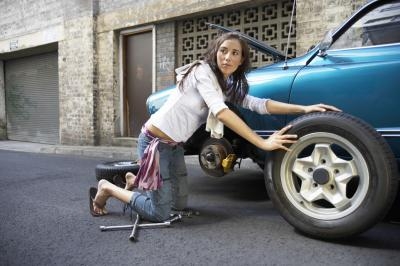
Hub assemblies have become popular since first used on front-wheel drive vehicles. They integrate the hub of the wheel with the wheel bearings and are centered on the spindle of the drive shaft. All-wheel drive vehicles are using hub assemblies and now, even four-wheel drive trucks and SUVs are using them. The internal bearings of the hubs require no servicing during brake jobs and four-wheel drive trucks don't need the front hubs serviced. Unlike free-floating bearings, the hub bearing assemblies do not allow any play when testing the tightness of the wheel.
Test drive the vehicle to determine if there is any noise emitting from the front or rear axles. Hub assemblies can give off a slight variety of noises; most commonly a growling or grinding noise. The noise can travel across the axle and make it hard to determine which side it is coming from, but it will intensify with the speed revolutions of the wheels. Other noises bad assemblies could include are squeaks, squeals or a high-pitched whining.
Determine on the test drive which axle the noise (if any) is coming from. If there are no noises present, but inspection of the bearings is still desired, proceed to Step 3. Front bearing noises (grinds and growls) can often be heard and even felt in the steering wheel and the floor pedals. Rear hub assembly noises can often be heard behind the driver and even felt in the seat while driving. This is because the noises travel across the axles and can often be a sensation felt as well as heard.
Park the vehicle on a paved and flat surface. Apply the parking brake only if checking front hub assemblies. If and when checking rear hub assemblies, the parking brake needs to be in the off position.
Place a wheel wedge up against the outer tread surface of a tire on the opposite axle from which is being lifted to check the hub assembly.
Lift the vehicle with the car jack and support the axle onto jack stands.
Place a hand on top of one tire and the other hand on the bottom of the tire and try to wiggle it up and down. If there is any play when performing this test, the hub assembly should be replaced. Free-floating bearings on front and rear axles allow slight play, so determining the wheel being inspected has a hub assembly is required. If the wheel does have a hub assembly and there is no play felt, proceed the other tire on the other side of the axle. If any wheel has play, that is most likely the bad bearing. If not, proceed to Step 7.
Spin the wheel and tire in the direction it would be moving forward as fast as possible. Try to determine if there is a coarse sound coming from the center of the tire. This is another sign of a bearing getting weak, even if there as no play in the hub assembly. Compare the two tires on the same axle to determine if one sounds more aggressive than the other. The one with the more noise usually indicates the wheel with the bad hub assembly.
Check the two tires on the remaining axle, if desired, but switch the wheel wedge over to the opposite axle before lifting the other axle.